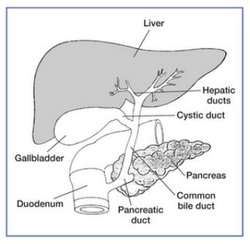Human digestive system: structure and major functions
a. Mouth: Mechanical breakdown of food by chewing and secret neutral salivary
b. Oesophagus: to push food down by peristalsis movement.
c. Stomach: Mechanical mixing and breakdown of food by peristalsis. Secret acidic gastric juice
d. Small intestine: (Duodenum & ileum) intestinal glands secret alkaline Intestinal juice
e. Large intestine: colon absorbs water and mineral salts. Faeces are stored temporarily in the rectum.
f. Liver: secret alkaline bile to help digestion of fats by breaking fats into minutes fat globules to form an emulsion ( emulsification) to increase the surface to volume ratio for easy digestion by the lipase.
g. Pancreas: secret alkaline pancreatic juices
b. Oesophagus: to push food down by peristalsis movement.
c. Stomach: Mechanical mixing and breakdown of food by peristalsis. Secret acidic gastric juice
d. Small intestine: (Duodenum & ileum) intestinal glands secret alkaline Intestinal juice
e. Large intestine: colon absorbs water and mineral salts. Faeces are stored temporarily in the rectum.
f. Liver: secret alkaline bile to help digestion of fats by breaking fats into minutes fat globules to form an emulsion ( emulsification) to increase the surface to volume ratio for easy digestion by the lipase.
g. Pancreas: secret alkaline pancreatic juices
Peristalsis Movement
The wall of the oesophagus is made up of 2 layers of muscles: Longitudinal muscle on the outside and Circular muscles on the inside. These 2 layers of muscles caused wave-like contraction (one contracts and the other relax) to mix the foods and push it down along the gut
Absorption of nutrients
Products of digestion are: water, minerals, simple sugars, amino acids, fatty acids and glycerol. The small intestine adapts for its functions by providing:
i. A large absorption surface by:
• The inner walls of the small intestine have numerous folds.
• The walls are also lined with villi.
• The epithelial cells of the villi have numerous microvilli.
ii. A long path to provide sufficient time for absorption.
iii. Richly supplied of blood capillary and lymphatic capillaries that carry absorbed food substance away so as to maintain a concentration difference for diffusion.
iv. A single cell thick epithelium to enable easy diffusion
Glucose and amino acids are absorbed by diffusion into the blood capillary or by active transport.
Glycerol and fatty acids diffuse into the epithelium, combined into minute fat globules and enter the lacteals.
Water and Minerals are absorbed by the ileum and colon.
Undigested food discharge as faeces through the anus.
i. A large absorption surface by:
• The inner walls of the small intestine have numerous folds.
• The walls are also lined with villi.
• The epithelial cells of the villi have numerous microvilli.
ii. A long path to provide sufficient time for absorption.
iii. Richly supplied of blood capillary and lymphatic capillaries that carry absorbed food substance away so as to maintain a concentration difference for diffusion.
iv. A single cell thick epithelium to enable easy diffusion
Glucose and amino acids are absorbed by diffusion into the blood capillary or by active transport.
Glycerol and fatty acids diffuse into the epithelium, combined into minute fat globules and enter the lacteals.
Water and Minerals are absorbed by the ileum and colon.
Undigested food discharge as faeces through the anus.
Usage of different nutrients by the body
Glucose: used for cells respiration, excess glucose converted to glycogen and store in liver & muscles.
Amino acids: used for making new proteins and protoplasm. Excess amino acid cannot be stored and are de-aminated in the liver.
Fats: are used for synthesis of cell membranes. Excess fats are stored as fat cells under the skin
Amino acids: used for making new proteins and protoplasm. Excess amino acid cannot be stored and are de-aminated in the liver.
Fats: are used for synthesis of cell membranes. Excess fats are stored as fat cells under the skin
Functions of the Liver
a. Regulation of blood sugar level:
i. Too high blood sugar level, Insulin is secreted by pancreas. Liver convert glucose into glycogen for storage in liver and muscles.
ii. Too low blood sugar, glucagon is secreted by pancreas. Liver convert glycogen to glucose.
b. Production of bile: bile helps in the digestion of fats and is temporarily stored in the gall bladder before use.
c. Breakdown of alcohol: liver break down alcohol into simple substances that can be used for respiration.
d. Deamination of amino acids: excess amino acids were converted into glucose with the amino group removed and converted to urea.
i. Too high blood sugar level, Insulin is secreted by pancreas. Liver convert glucose into glycogen for storage in liver and muscles.
ii. Too low blood sugar, glucagon is secreted by pancreas. Liver convert glycogen to glucose.
b. Production of bile: bile helps in the digestion of fats and is temporarily stored in the gall bladder before use.
c. Breakdown of alcohol: liver break down alcohol into simple substances that can be used for respiration.
d. Deamination of amino acids: excess amino acids were converted into glucose with the amino group removed and converted to urea.




